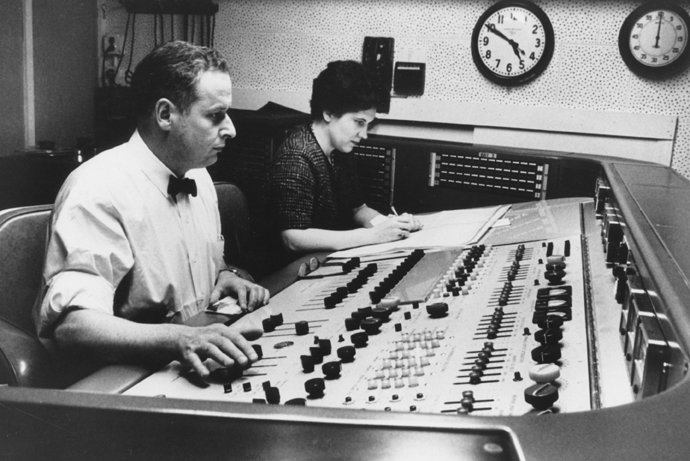 C. Robert Fine and Wilma Cozart Fine c.1961 (Source: T. Fine)
C. Robert Fine and Wilma Cozart Fine c.1961 (Source: T. Fine)
Today at Preservation Sound dot com we are pleased to present a special guest: T. Fine, son of high-fidelity recording pioneers C.R Fine and W.C. Fine. The elder Fines were active studio owners/engineers in the early days of stereophonic LP recording and their efforts brought the world one of the most successful series of LPs ever manufactured: Mercury Records’ Living Presence series (click here for a contemporary reissue of much of this material).
The younger Mr. Fine presents a history of Fine Recording, INC., the studios, and the equipment that was used; he has also generously provided PS Dot Com with some previously unavailable images of the operation. We’ll begin with a five-page article from Popular Science (1967) which documents a recording session at Fine Recording, INC.
Click here to read the original article at Popular Science Dot Com
(image source: Popular Science, August 1967)
T. Fine: ” Fine Recording Inc. (h.f. FRI) was a production complex that eventually encompassed four studios, extensive disk-mastering operations, and Walter Sear’s Moog laboratory. FRI was located in the Great Northern Hotel on 57th Street in Manhattan.
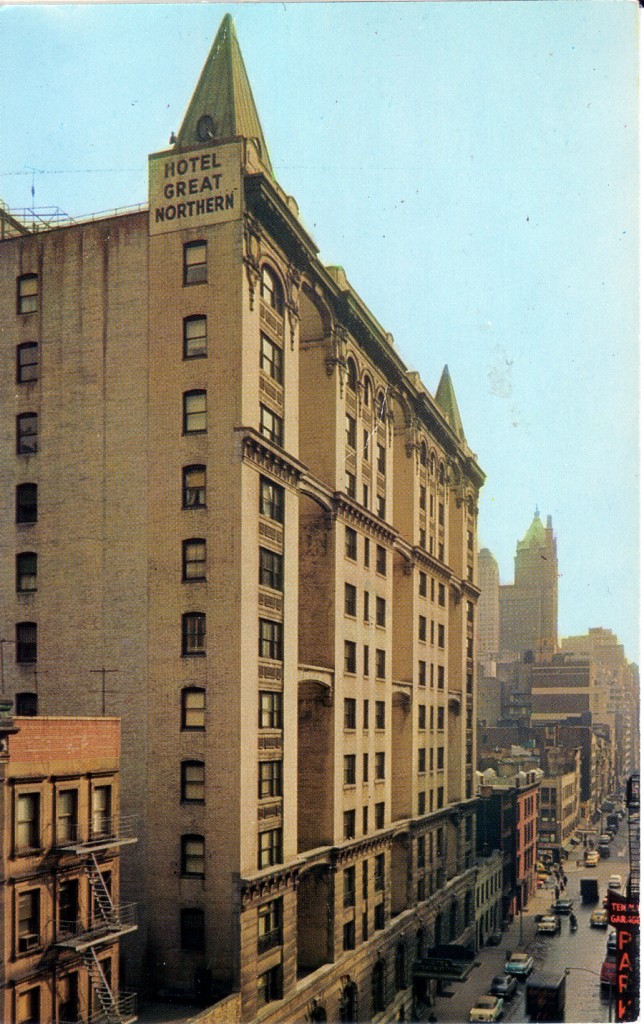 The Great Northern Hotel, Home of FRI., as it appeared in the 1950s (SOURCE: T. Fine)
The Great Northern Hotel, Home of FRI., as it appeared in the 1950s (SOURCE: T. Fine)
“The building was torn down in the late 1970’s and the Parker Meridian Hotel is on the site now.
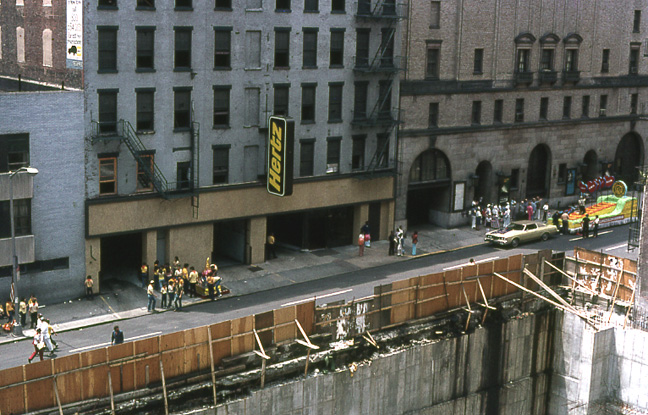 Pouring of the foundation of the Parker Meridian taken from the 7th floor of Sterling Mastering circa 1977 (photo: Bob Ludwig)
Pouring of the foundation of the Parker Meridian taken from the 7th floor of Sterling Mastering circa 1977 (photo: Bob Ludwig)
“Fine Recording began operation in 1957, first doing mixing and disk mastering while the hotel’s former Ballroom was transformed into a recording space.
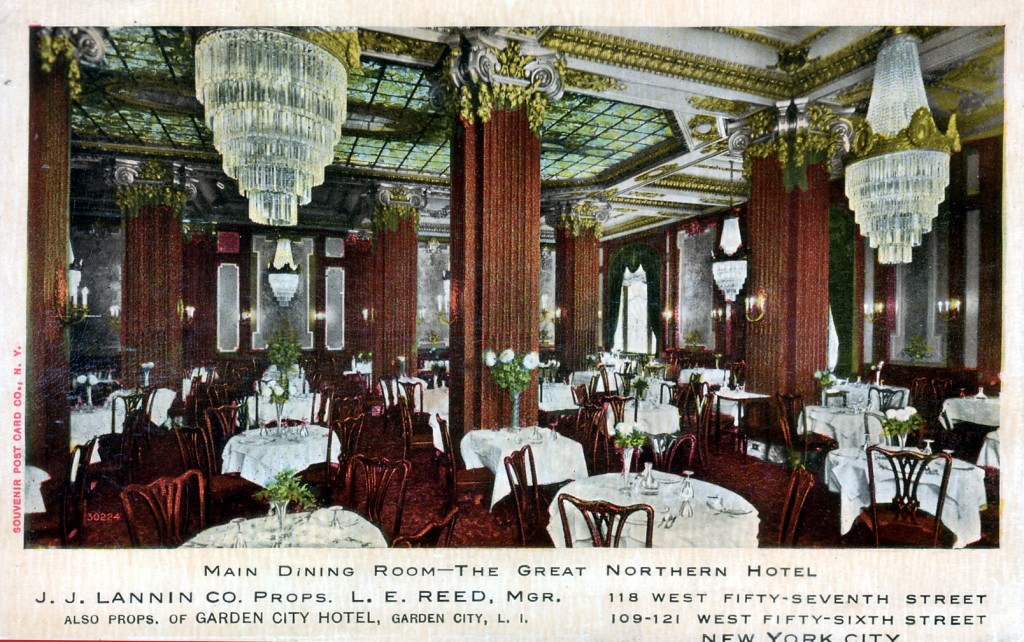 Above: The ballroom of the Great Northern Hotel c. 1900, later to become Fine Recording Studio A. The Tiffany glass ceiling remained throughout. (SOURCE: T. Fine)
Above: The ballroom of the Great Northern Hotel c. 1900, later to become Fine Recording Studio A. The Tiffany glass ceiling remained throughout. (SOURCE: T. Fine)
“In the summer of 1958, the first recording sessions took place in Ballroom Studio A, and continued almost daily until 1971. Studio B, which was located in what had been the ballroom’s service kitchen, was used for small-group sessions, voice-over recording, transcription services and other purposes not requiring a large recording room.
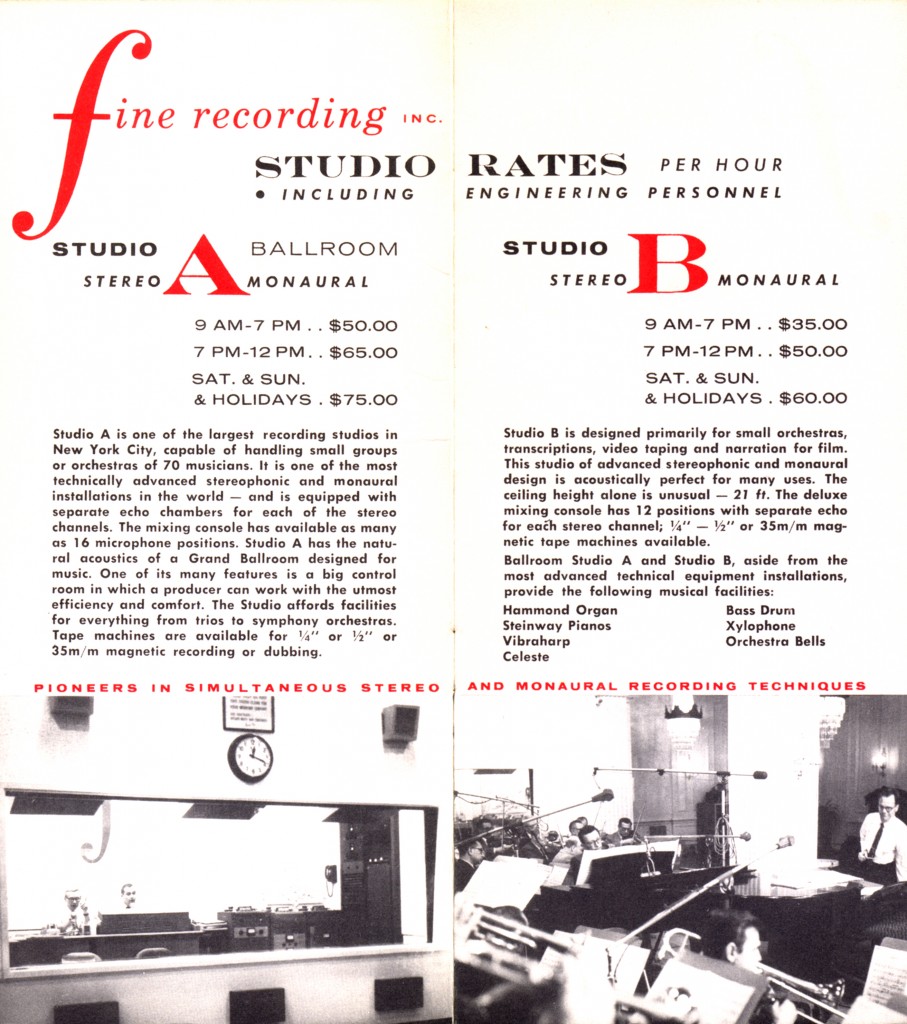 Fine Recording, INC rate-card c. 1959. In today’s currency: multiply by 11. (SOURCE: T. Fine)
Fine Recording, INC rate-card c. 1959. In today’s currency: multiply by 11. (SOURCE: T. Fine)
“A growing sound-for-film business required a film-specialized space, and Studio C was built in 1959, in the suite of rooms on the top floor where conductor Dimitri Mitropoulos had lived. A few years later, the adjoining suite became available, and Studio D was built as a second sound-for-picture studio. Studio C and D shared a film-machine room and both were equipped for 35mm and 16mm synchronized picture and sound work. The disk-mastering suite, also on the penthouse level, had stereo and mono mastering rooms.
In the late 60’s, Walter Sear had a studio/Moog synthesizer production lab on the 12th floor. Sear was Walter Moog’s NYC regional representative and he provided Moog effects exclusively to Fine Recording clients. After the success of Walter (later Wendy) Carlos’s Moog album, “Switched On Bach” (Columbia), other artists quickly jumped on the Moog bandwagon. Among them were Dick Hyman and Richard Hayman, who recorded several Moog-centric albums for Command. (Ed. note: click here for an excellent Moog cut from Hyman). Walter Sear did the Moog programming and some of the engineering on those albums, and also recorded his own Moog album for Command, “The Copper Plated Integrated Circuit.”
From the early 1960’s until the end of operations, there was a large tape-duplicating operation in the basement. Duplicating was originally set up for quarter-track, full-track and 2-track reels, but Fine Recording was also one of the first east coast facilities to duplicate 4-track “Muntz” cartridges, 8-track Lear cartridges and the Philips Compact Cassette.
The studio ceased operation and was sold to Reeves Cinetel in 1971.
************
*******
***
As for equipment: Studio A started out with a Gates Dualux mixing console, which was modified heavily over the years. By 1960, a center-channel buss had been built, and facilities for echo send and return were present from the get-go. The version pictured in the PopSci article (see above – ed.) shows the full extent of the modifications.
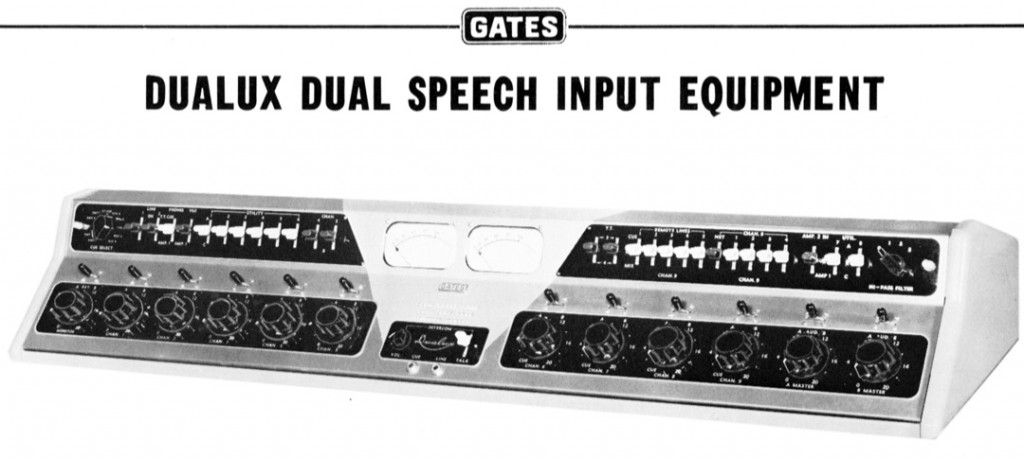 Above: the 1960 Gates Dualux console, a slighter later version than installed at FRI. The Dualux at FRI used 5879 tubes in the mic preamps rather than EF86. Click here to DL schematics for the Gates 5879 preamps: Gates-M5215_preamp. Click here to download data on the Gates Dualux: Gates_Dualux_1960
Above: the 1960 Gates Dualux console, a slighter later version than installed at FRI. The Dualux at FRI used 5879 tubes in the mic preamps rather than EF86. Click here to DL schematics for the Gates 5879 preamps: Gates-M5215_preamp. Click here to download data on the Gates Dualux: Gates_Dualux_1960
“Fine Recording did not use the Gates Console’s line amps. Instead the console outputs went through Altec 322C Limiter Amplifiers, which were set to a fixed gain (click here to DL the Altec 322C schematic: Altec-322C)). If you wanted a clean, linear signal (IE., no compression), you just used the console channels conservatively. If you drove the channels beyond a certain level, you’d hit the threshold of the limiter/compressor. This is how the “Command Sound” was achieved, characterized by bright up-front horns and crunched drum set, but retaining dynamics and punch in the percussion. (ed. note: ‘Command’ was a prominent record label in the 1960s. For an example of the typical Command sound, click here)
Regarding the session depicted in the Popular Science article: it is of special interest because the master medium was 35mm magnetic film, not tape. The article covers the process from session to mastering to pressing plant. The record in question was one of Enoch Light’s early releases on his Project 3 label (Light started that label after he left Command Records in 1966).
(image source: Popular Science 8/67)
“In 1969, Studio A was rebuilt. The new Audio Designs & Manufacturing (ADM) console installed was, at the time, among the largest desks outside of Hollywood.
Above: The Fine ADM Console. (SOURCE: T. Fine)
“It featured early assign-automation featuring a patented system. Studio A was originally mono and 2-track. It later evolved to mono and 3-track, and the 1969 build was for 16-track recording and also 6-track monitoring and mixing for films.
Studio B started out with an RCA console from the former Fine Sound studio on 5th Avenue. This desk had been rebuilt for 3-channel in the mid-50’s (it was based on 3 separate mixers of 4 inputs each, with 3 echo sends and returns). In 1967, Studio B was rebuilt for 8-track, with a new ADM mixing desk. In those days, engineers like to monitor all the tape tracks, but using 8 Altec 604 monitors was not practical. Fine Recording contacted JBL and the famous JBL model #4310 three-way monitor (which was also sold by the thousands as a home-stereo speaker, the Century L-100) was born. (click here to download further information regarding the JBL/ FRI connection). Studio B later evolved to a 12-track (a short-lived 1? tape format made by Scully), and then 16-track.
Studio C, the first film-mixing room, had a 1940’s vintage Western Electric/MGM all-passive console, also originally installed at Fine Sound on 5th Avenue. The console took line-level from the machine room and its output was down to about mic level, so Altec amplifier/compressors were used to get back the gain and control peak modulation. Hundreds of films, TV commercials, and special productions were mixed on this console over the years. It later lived at Sear Sound and is now owned by the Museum of Sound Recording group. Studio D’s console was the first all-transistor board at the studio, built in 1966 out of early ADM modules by studio chief engineer Bob Eberenz.
Monitoring was done on Altec A7’s powered by McIntosh amps. Studio B eventually ended up with 8 JBL 4310 speakers powered by smaller McIntosh amps. Tape machines were generally Ampex, but there were Scully 8-tracks and 12-tracks in Studio B for a while. Mics included a bunch of U-47’s, a bunch of RCA ribbon mics (mainly 44BX and 77DX), some EV 666 dynamics, Church mics acquired from Everest, Schoeps M201’s (used on the Mercury Living Presence recordings, and in the studio), and a few other types here and there. There were Pultec equalizers all over the place. Also, there were many special-purpose effects devices and modifications to “stock” pieces in order to gain various sounds and effects desired by clients.
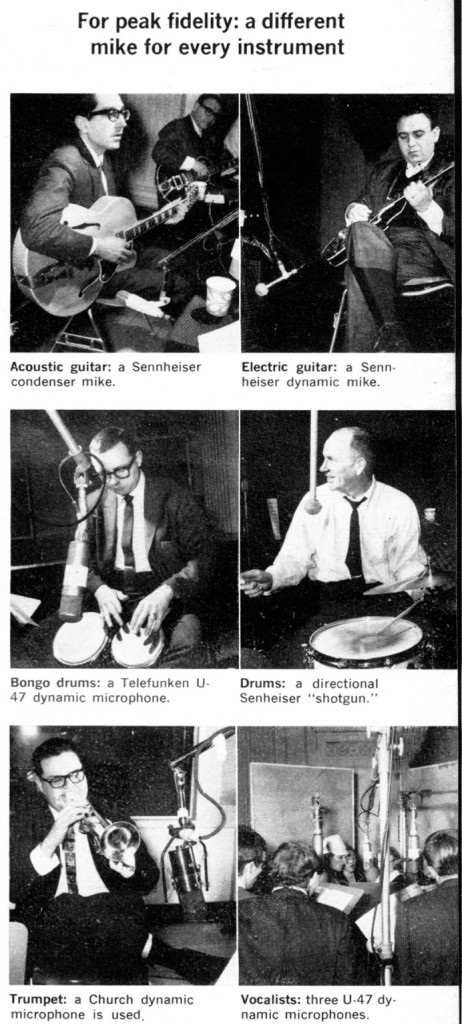 From Popular Science 8/67: The mics of Fine Recording. Evidently there was some editorial confusion regarding microphone-type classification.
From Popular Science 8/67: The mics of Fine Recording. Evidently there was some editorial confusion regarding microphone-type classification.
“The cutting lathes were Scully, with customized Westrex heads. Stereo cutting amps were McIntosh 200W, capable of 1kW clean peak power! Mono cutting amps were Westrex. Most of the equipment in the duplicating operation was customized or modified.
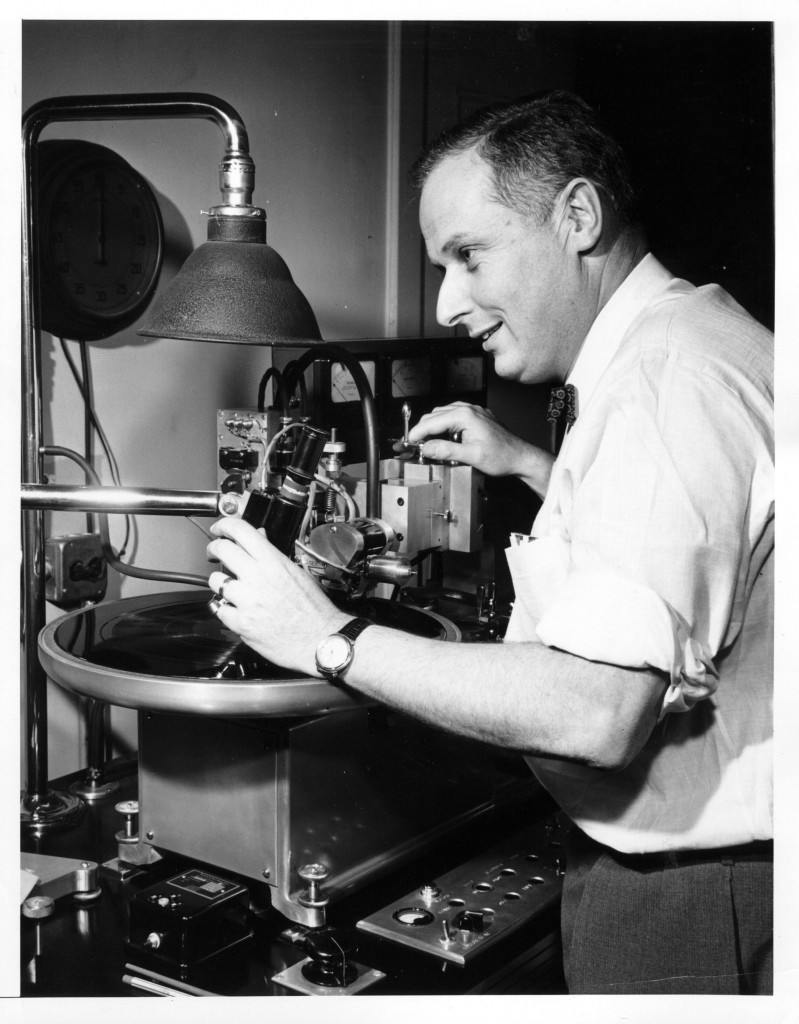 R. Fine at the Lathe, c. 1959 (SOURCE: T. Fine)
R. Fine at the Lathe, c. 1959 (SOURCE: T. Fine)
“In 1960, Fine Recording acquired the defunct Everest recording studio in Bayside Queens (see image at head of this article – ed.). This was operated as a separate studio for several years. The Everest studio had a custom Westrex console and was designed for 3-channel 35mm mag-film recording. Eventually, the Bayside location was shut down and the equipment integrated into the Manhattan facility. The old Westrex console sat in a store room and was eventually tossed; think of the value of those components today! (UPDATE: we’ve added detailed information about the Fine Bayside location at the end of this article. Click here and scroll down to read more).
The principle players at Fine Recording were owner/president C. Robert Fine, VP and head of mastering George Piros, VP and chief technical engineer Bob Eberenz. Notable recording engineers who worked at the studio over the years included Fred Christie (later of MediaSound), Russ Hamm (Sear Sound, Gotham Audio), Walter Sear (Sear Sound), John Quinn (The Mix Place), Kenny Fredrickson (The Mix Place) and Gerry Block (Sigma Sound Studios NYC). Projectionists, machine room techs and various other employees also had long careers around the NYC studio scene.
Along with owning and running the studio, Bob Fine owned a recording truck, used primarilly to make the Mercury Living Presence classical recordings. His wife, Wilma Cozart Fine, was the VP of classical music at Mercury Records until she retired in 1964 to raise their family. Bob Fine was also an inventor, receiving ten U.S. patents. After Fine Recording, Bob Fine worked for Reeves Telecine until 1974, and then worked as a consultant and studio designer. Fine designed, oversaw the building of, and initially ran the Armstrong Audio/Video complex in Melbourne Australia (later AAV Australia). He later worked at The Mix Place in NYC. Bob Fine passed in 1982. Wilma Cozart Fine returned to the music business in the 1990’s, remastering more than 100 Mercury Living Presence albums for CD release. Wilma Fine passed in 2009.”
Follow the link below for a list of some noteable albums recorded at Fine Recording INC. And for an excellent + thorough interview of Bob Fine by Bert Whyte, click here to download: Audio-681_Fine_Recording.pdf
Some albums and songs recorded at Fine Recording:
Terry Snyder: Persuasive Percussion (Command) and Mr. Percussion (United Artists)
Enoch Light: Provacative Percussion, Stereo/35mm, Big Band Bossa Nova and many other albums (Command and Project 3)
Dinah Washington: What a Diff’rence A Day Makes and several other albums (Mercury)
Vaughn Meader: The First Family (Cadence)
Quincy Jones: Birth of a Band, The Big Wide World of Quincy Jones (Mercury)
Shelly Manne: 2-3-4 (Impulse)
Max Roach: It’s Time (Impulse), The Many Sides of Max Roach (Mercury)
Buddy Rich: The Driver and The Voice is Rich (Mercury)
Buddy Rich/Max Roach: Rich Vs. Roach (Mercury)
Sil Austin: Plays Pretty For the People (Mercury)
Dick Hyman: Provacative Piano, Moog, The Age of Electronicus and many other albums (Command)
Doc Severinsen: Fever and many other albums (Command)
Urbie Green: Persuasive Trombone, The Urbie Green Six-Tet and other albums (Command)
Barbara Steisand: early demos
Judy Collins: first two albums (Elektra?)
Les Brown/Vic Schoen: Stereophonic Suite for Two Bands (Kapp)
Otis Spann: Otis Spann Is The Blues (Candid)
Lightenin’ Hopkins: In New York (Candid)
Sarah Vaughn: No Count Sarah and several other albums (Mercury)
Jimmy Cleveland: A Map of Jimmy Cleveland (Mercury)
Clyde Otis: American Dance Favorites (Mercury)
Walter Sear: The Copper Plated Integrated Circuit (Command)
Richard Hayman: Voodoo (Mercury) and Genuine Electric Latin Love Machine (Command)
Janos Starker: Bach Cello Suites (Mercury Living Presence)
Byron Janis: Pictures at an Exhibition (Mercury Living Presence)
The Romeros: The Royal Family of the Spanish Guitar and others (Mercury Living Presence)
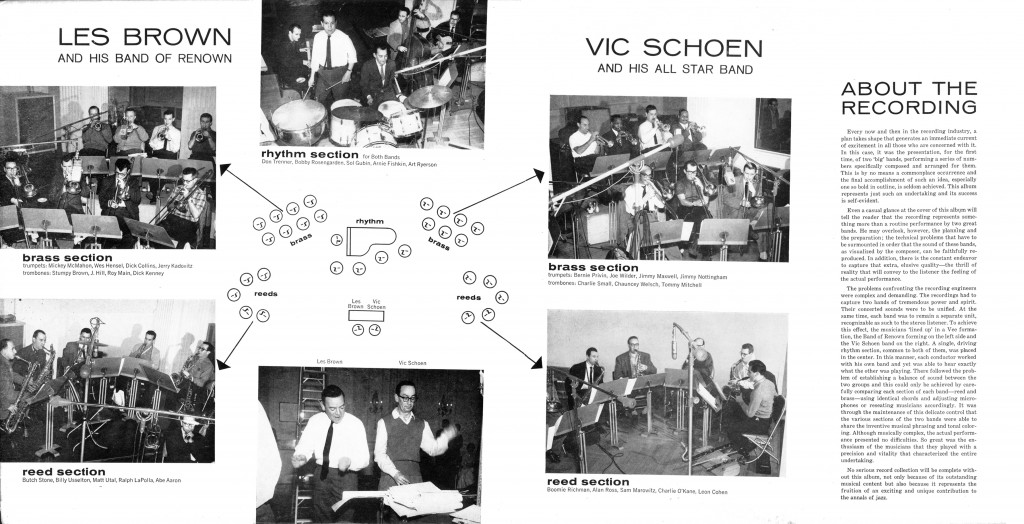 Above: the inner gatefold of “Les Brown And His Band Of Renown; Vic Schoen And His All Star Band,” engineered by R. Fine.
Above: the inner gatefold of “Les Brown And His Band Of Renown; Vic Schoen And His All Star Band,” engineered by R. Fine.
************
*******
***
Ed. Note: T. Fine has provided us with some beautiful images of the Bayside Queens studio that R. Fine operated simultaneously with Fine Recording INC. We present those images and an account of that operation here:
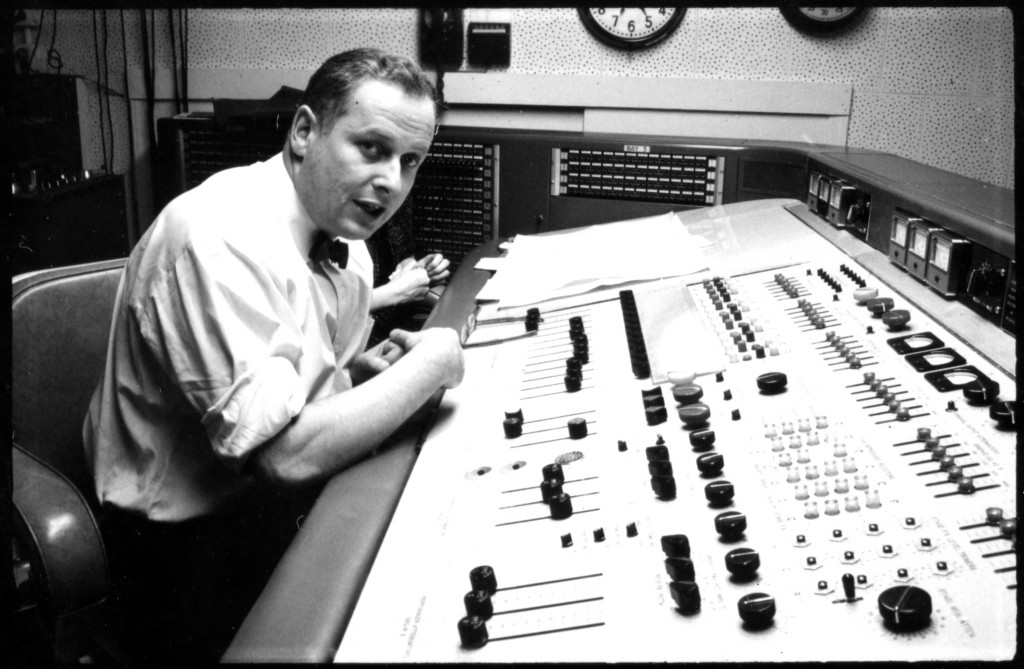 R. Fine at the Bayside Westrex Console (SOURCE: T. Fine)
R. Fine at the Bayside Westrex Console (SOURCE: T. Fine)
T. Fine: ” In the late 1950’s, Everest Records made a brief splash in the music business with high-fidelity records made using 35mm magnetic film instead of magnetic tape. Everest, which was a division of Bellock Industries, built a large studio in Bayside, Queens. The studio was outfitted with Westrex 35mm film recorders, a custom-made Westrex console, and Ampex 300 3-track tape recorders. Everest also had Westrex/Scully LP mastering facilities, and three portable Westrex film recorders. In its brief time in business, Everest made a few dozen classical and pop records from 35mm film masters.
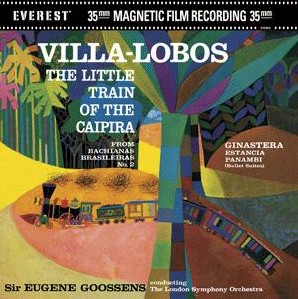 The Everest studio was equipped with several Church microphones, an interesting development that came out of Hollywood in the early 1950’s. Stanley Church of the MGM Sound Department took a Neumann U-47 capsule and built a new body and electronics for it to better suit the needs of film-dialog recording and to allow MGM to use its standard American parts for easy service. Not very many Church microphones were made. They were hand-assembled by Church and his family, according to published reports. (at left: An Everest LP release of the 1950s. SOURCE)
The Everest studio was equipped with several Church microphones, an interesting development that came out of Hollywood in the early 1950’s. Stanley Church of the MGM Sound Department took a Neumann U-47 capsule and built a new body and electronics for it to better suit the needs of film-dialog recording and to allow MGM to use its standard American parts for easy service. Not very many Church microphones were made. They were hand-assembled by Church and his family, according to published reports. (at left: An Everest LP release of the 1950s. SOURCE)
Bellock Industries closed down the money-losing Everest Records in either late 1960 or early 1961. An excellent history of Everest Records by Lonn Henrichsen and David Patmore was published in Classic Record Collector magazine in the Spring 2007 and Summer 2007 issues. Westrex’s John G. Frayne and J.W. Stafford wrote an article in the July, 1960 issue of the AES Journal describing Everest’s Bayside facility and the methods involved with using 35mm magnetic film as a recording and mastering medium.
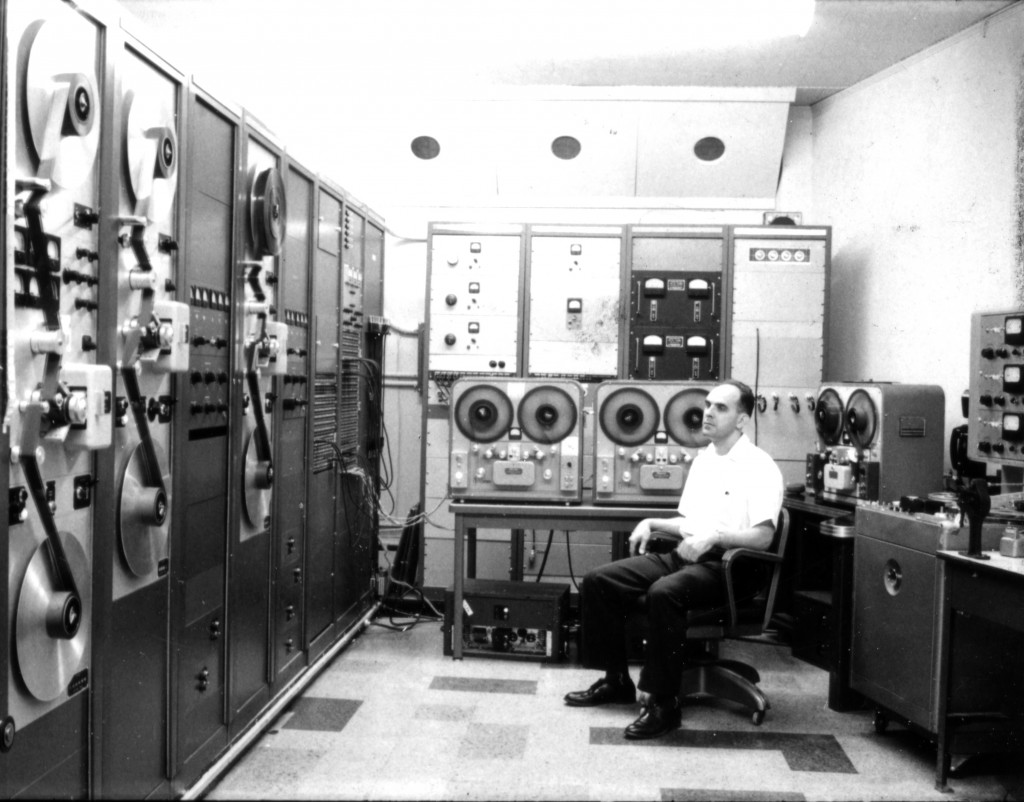 Above: the Fine Bayside Machine Room (Source: T. Fine)
Above: the Fine Bayside Machine Room (Source: T. Fine)
Fine Recording bought the Everest studio and equipment in 1961 and went on to make a few dozen 35mm-master LPs for Mercury, Command, Project 3 and Cameo/Parkway, both classical and pop titles. The first session using the new equipment was for Mercury Living Presence, in Rochester NY on May 6, 1961. Records made in the Bayside studio included “Fred Fennell Conducts Cole Porter” for Mercury, “Around The World with Quincy Jones” for Mercury, “The School For Scandal” soundtrack for Command, Duke Ellington’s “Recollections Of The Big Band Era” for Reprise and others.
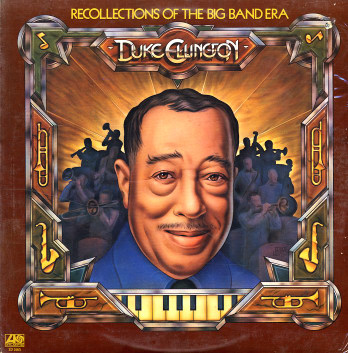 Duke Ellington’s “Recollections Of The Big Band Era,” recorded at Fine Bayside (SOURCE)
Duke Ellington’s “Recollections Of The Big Band Era,” recorded at Fine Bayside (SOURCE)
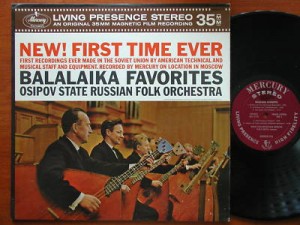 The portable film-recording equipment made several trips to Europe in 1961-63, recording for Mercury, and was used in Mercury’s famous trip to Moscow in 1962. See at example at left (SOURCE). This marked the first time that an American recording crew used American equipment to record Soviet musicians and orchestras. Command Classics records were also recorded on the portable film equipment, perhaps the most famous records were made with William Steinberg and the Pittsburgh Symphony and also solo organ records by Virgil Fox. The final Pittsburgh 35mm recording was made in 1968 and was written about in High Fidelity magazine (July 1968).
The portable film-recording equipment made several trips to Europe in 1961-63, recording for Mercury, and was used in Mercury’s famous trip to Moscow in 1962. See at example at left (SOURCE). This marked the first time that an American recording crew used American equipment to record Soviet musicians and orchestras. Command Classics records were also recorded on the portable film equipment, perhaps the most famous records were made with William Steinberg and the Pittsburgh Symphony and also solo organ records by Virgil Fox. The final Pittsburgh 35mm recording was made in 1968 and was written about in High Fidelity magazine (July 1968).
Another view of the Fine Bayside Westrex Console. Source: T. Fine
The photos reproduced here show the Bayside studio circa 1962, after Fine Recording made some changes to the equipment layout and rebuilt the monitoring system. All three images are from a single mixing session for Mercury’s “The Civil War” album. The Westrex console was big and complex for a recording studio board of that era but relatively simple compared to some Westrex installations in Hollywood. The monitors visible are three Altec A7’s, as were used in Fine Recording’s Manhattan control rooms. In the machine room image we see Westrex studio and portable recorders in use. The equipment compliment also featured Ampex 300 3-track tape recorders. Everest’s disk-cutting equipment was moved to Fine Recording’s Manhattan location.
Fine Recording shut down the Bayside studio in the mid-60’s. The Westrex film equipment was integrated into the Manhattan sound-for-picture studios, as can be seen in the 1967 Popular Science photos.”
Above: the former site of Fine Bayside as it stands today on 41st Ave in Queens NY. (SOURCE)
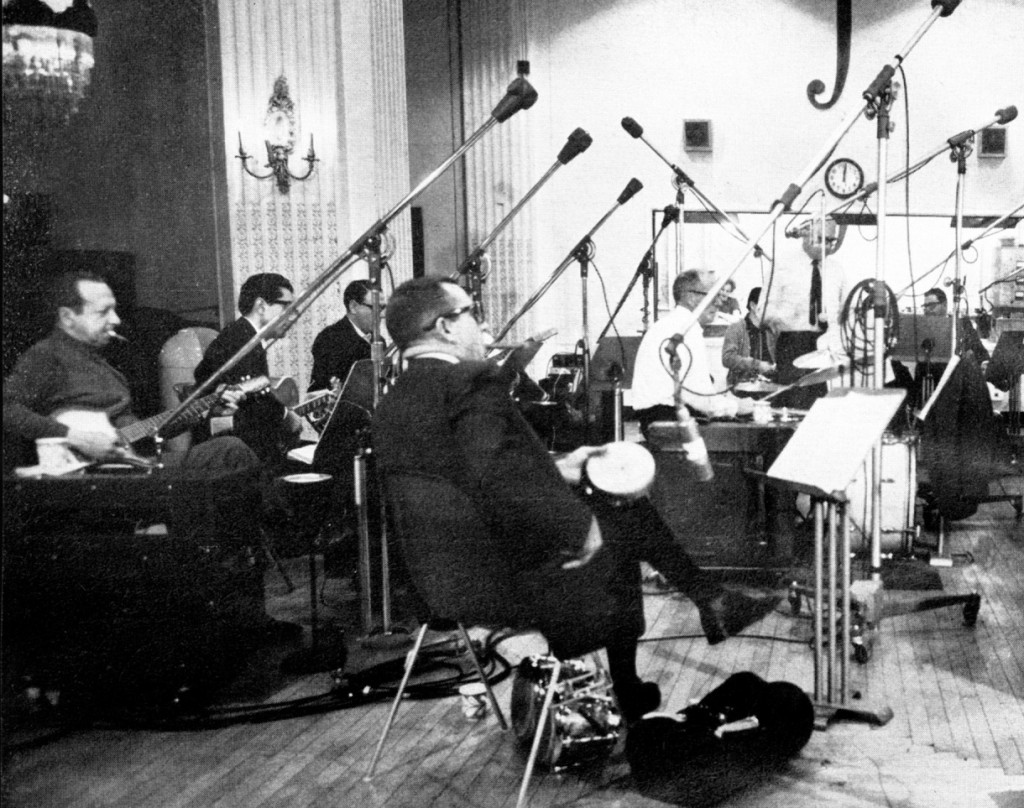
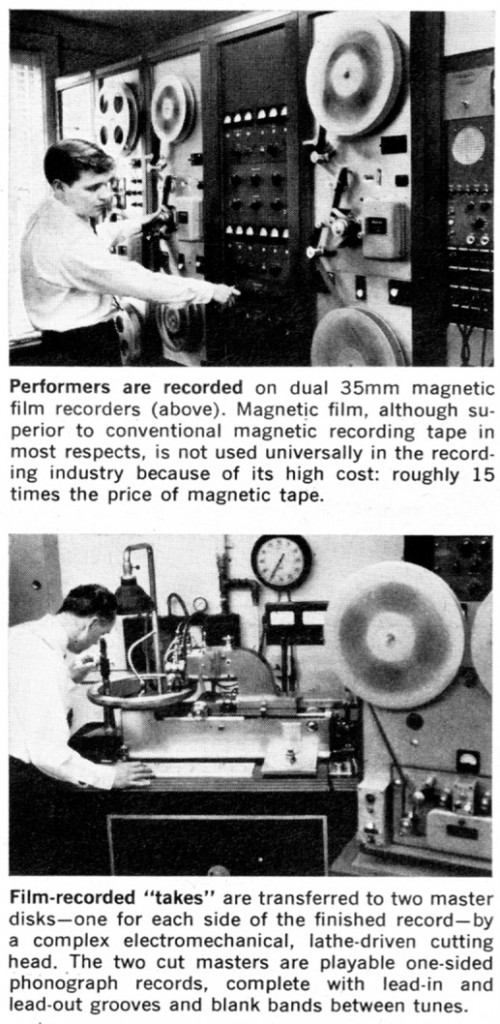
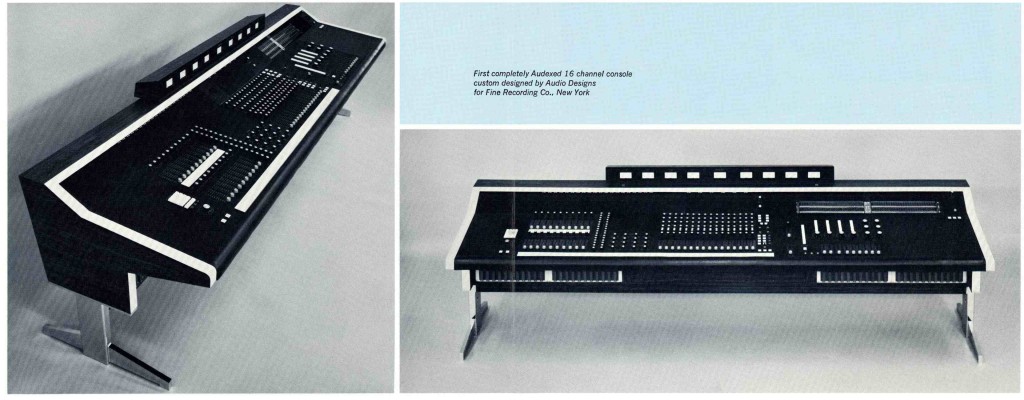
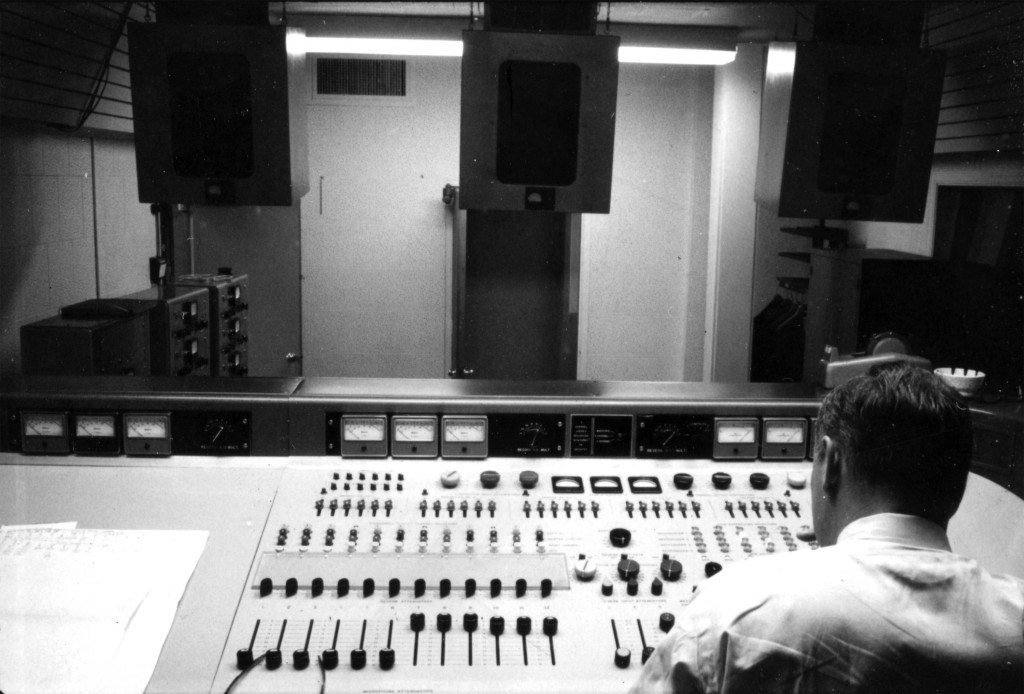
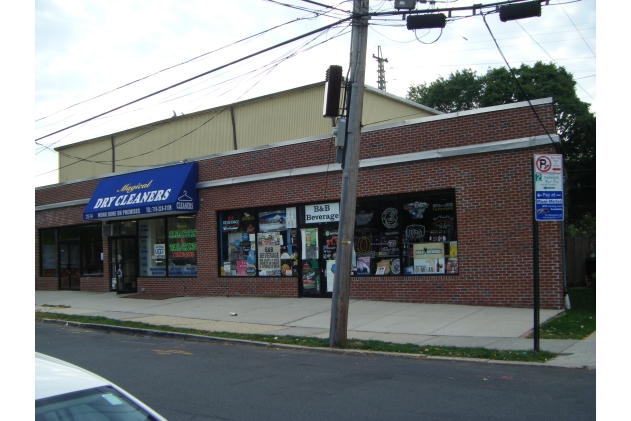
63 replies on “Fine Recording Inc: Pioneers in High-Fidelity Studio Recording: UPDATED – 5”
Ah, those were the days. Bob Fine in New York, and Bill Putnam in Hollywood. I had the pleasure of working for Bill a number of years. Both Chicago and Hollywood.
Nice article. Now that I see these pics, I think I recall the Gates console sold on ebay in the early 2000’s. It had a pretty involved modification. The book ‘Too Hot to Handle’ apparently incorrectly suggests the Gates console was an earlier SA-50 console.
Chris, you did a really fantastic job with this. Thank you for updating as more facts came in. Regarding Doug Williams’ comment, most published accounts of Fine Recording are not 100% accurate. I would say this web page is as close as it gets. I got fact-checking feedback from actual FR employees, plus referred to old photos and documentation. I also sent around old photos and documentation to jog the memories of first-person participants. So what you read above is factual. — Tom Fine
This is great to see – I’ve been an admirer of C.R. Fine’s work for many years.
Hello Tom Fine,
I’m wondering if the “ƒ” etched on vinyl deadwax is one of the mastering signature of Fine Recording Inc.
See > http://cdn.discogs.com/z5vm0dn66UtiYHBQoAAhahaodig=/fit-in/600×454/filters:strip_icc():format(jpeg):mode_rgb():quality(96)/discogs-images/R-5554022-1448548399-3414.jpeg.jpg
Thanks for your help
I knew Bob Fine only as a very friendly competitor of Cue Recording Studios. I was the chief engineer there for many years. Mel Kaiser, the owner, and Bob were good friends. Nothing but good to say about Bob or his studio. This brings back good memories.
Chris:
Great piece on the history of Fine Recording. It’s great to see this put together in one place.
Scott D. Smith CAS
Wow! This mornings Goggle Doodle (re:the Moog synthesizer) rang a distant, childhood bell – I thought it might have had some connection to my fathers work at Fine Recording in the 1960’s, so I gave Fine Recording a Google search- and here I am! My father, Copthorne Macdonald, worked with Bob Fine at the Great Northern as an electronics engineer in the late 1960’s. When I was 9 years old I came to live with him in New York, in a small suite of rooms at The Great Northern. While I only lived in the hotel for a few months, it was both an amazing time and an amazing experience. My Dad passed away last December and as often happens when you lose someone (who you were sure would always be there) – you realize how many questions you forgot to ask. This article answers at least a few of them. Thank you so much!
Beth Drummond (nee:Macdonald)
Hello — I am a writer in Washington, DC, working on a book about the early history of the Beach Boys, the vocal group from Southern California currently celebrating their 50th anniversary. There is some anecdotal evidence they may have recorded at Fine Studios in NYC in January 1963, and it may have been a vocals only session. Does this ring a bell with anyone? Is it even remotely possible? If this message could be relayed to T. Fine, perhaps studio logs or other documents might shed some light on this matter. Thank you in advance for any help you might offer. And thank you for a very enjoyable website. All the best — Jim Murphy
Cop Macdonald was a ham radio operator and had a column on something or other in the old Mother Earth News. My sister the hippie read it religiously.
This is really for Beth and T. Fine but should be of interest to others:
As a young broadcast engineer I was always wondering why the radio spots that came into us from United Sound Systems in Detroit sounded better than all of the other studios. see:(http://www.soul-source.co.uk/_/articles/soul-articles/ed-wolfrum-detroit-sound-r2445)
This prompted a trip to see United Sound and this visit directly resulted in my over nearly 50 year career in audio.
When visiting at United it’s owner Jimmy Siracuse, took me around and showed me the studio. For a young 16 year old it was an experience. However the payoff of this visit was yet to come. While sitting at the kitchen table on the second floor of United, Jimmy was called away for a phone call. when he came back he asked if I would like to run up to Orchestra Hall as a buddy of his Bob Fine has a problem with a noisy microphone and he as going to let him borrow one of his. I said certainly and the friend ham radio friend who I came with piled into Jimmy station wagon and drove to Orchestra Hall in Detroit, about a mile or so from United.
When we arrived Jimmy was warmly greeted by Bob Fine and we went into the hall where a rehearsal was proceeding. We were all introduced to Bob Eberenz and to the conductor Paul Paray. Jimmy unpacked the mike and it was put into position by Bob and the rehearsal started again. Bob listened for a while and we were the escorted into the “truck”.
In the truck was a small mixer, 2 Ampex 300 recorders and a Westrex 3 channel 35 mm recorder sitting on a cobbled bench above the mixer. I was not too impressed after having just been to United Sound. That all changed when Bob Eberenz open the faders.
This was my introduction to real ” High Fidelity” recording and my life has never been the same since. I realized then that this is what God intended for me and it was a direct result of this interaction with Jimmy and the two Bobs. I remember that truck as if it happened yesterday.
I ended up as an engineer at United Sound, Detroit and later as the Chief Engineer for a few years before it’s sale to Don Davis.
Sorry to be so long winded…but wait, there’s more:
During my near 10 year stint at United and some years later, I was asked to drop off a master at Bob Fine’s place by Jimmy’s closest friend Artie Field on a trip to a N.Y. AES convention. There I was, surprisingly remembered by Bob Fine and then introduced to Cop MacDonald who Jimmy must have told I was a Ham operator. What transpired there was a meeting of audio minds I will never forget. Cop was one of the warmest and nicest men of audio I had the pleasure of knowing. It is no wonder you dad was with the great men of audio like Bob Fine and Bob Eberenz. Great men flock together it seems and Bob Fine Studios had a flock of them.
After that first “eyeball QSO” Cop and I had many more on the 75 meter amateur band. I was sad to see Cop become a “Silent Key”. Both his Ham, and his Audio Buddies will miss him.
73,
Ed
Hi Ed Wolfrum:
Very interesting stories indeed.
Let me probe your memory about the day you brought the microphone over to the Detroit Symphony recording session. Do you specifically remember old Orchestra Hall (then the Paradise Theater, according to the Mercury session books)? Do you specifically remember seeing the 35mm machine? I don’t think both could be the same memory on the same day. Here’s why — before the time Mercury was making 35mm recordings, the venue in Detroit changed to Cass Technical High School’s auditorium.
Detroit was a challenge for Mercury until the last years. Originally, for various reasons of orchestra management politics, courtesy, etc, the recording venue had to be Edsel Ford Auditorium, which was a terrible acoustic space (an Edsel, if you will). That venue was usable for mono recording but became intolerable when stereo recording began in 1956. So the switch was soon made to the dilapidated old Orchestra Hall, which was called the Paradise Theater in those days and was not in a very nice part of town. The switch wasn’t complete until 1959, with some stereo sessions in 1956-58 taking place at Ford Auditorium. The Paradise Theater recordings have more “air and space” and sound “bigger” due to a more open and reverberant acoustic space. As soon as the Cass Technical High School auditorium was “discovered” (and it may well have been discovered via a tip from one of the local recording engineers), it was used. And that “discovery” happened in 1960, before the 35mm rig was added to the Mercury arsenal. Combining 35mm quality with Cass’s acoustics resulted in the lush, deep and detailed sound quality of the later Mercury recordings from Detroit. By then, Paul Paray had built a superb orchestra, and 10 years of working together had formed a brilliant musical dynamic.
So if you brought that mic over to the Paradise Theater, it was pre-35mm. The switch to Cass took place in 1960, and the first 35mm session was in the spring of 1961. All of this comes directly out of the Mercury session books.
Also of interest — do you remember what type mic you brought over to the Mercury session? Did United have any Schoeps M201 mics? By 1959, Mercury was using an array of 3 Schoeps M201 mics, so it’s very interesting if something different was used in a later session because of technical problems. It’s entirely possible, anyone who owns old mics knows that they can develop tube noise, resistor noise, cable noise, capsule noise or other problems, especially when taken on the road.
Thanks for your stories, very interesting! Any other details you can pull out of your memory banks are greatly appreciated.
— Tom Fine
I suppose it’s possible that the orchestra
Hello Tom,
It was a Schopes M201 that Jimmy brought over to Orchestra Hall on that day. I was also most likely Jimmy to “hipped” your Dad to Cass Tech, which was a great room too. From the appearance that day and phone calls to and from your father and Jimmy, it appears that there was both a profession and personal relationship between them. I know that we received many advertising master tapes from Fine Recordings and were shipping them our auto industry advertising masters for the east coast market all item time.
I have also recorded in Orchestra Hall both before and after it’s restoration but in that process has lost some of it breadth and dimension. The old Cass Tech on the other hand has been demolished and replace with a new building. I am aware of all of the politics and pressured of the DSO which was part of the reason Paul Paray let the DSO as I have been told. I have also recorded in the old Ford Auditorium on numerous occasions.
I do remember the 35 mm machine in the truck sitting on a cobbled 2×4 shelf arrangement above a small console, however. But that was almost 50 years ago but the picture of that trucks interior is etched into my mind. perhaps they were not using that at the time.
Funny, but I also remember an uncovered incandescent light bulb that was hanging from the ceiling in the truck. Amazing what the mind collects.
When I was doing some recording with the Orchestra and in the studio years back Paul Ganson, a member of the orchestra at the time and was involved with the saving of Orchestra Hall brought over an 8x 10 picture that he had found in the archives of one of these sessions and the M201s were in that shot. I wish we had the great scanner we do now as I would of liked to have had that shot. Paul is still in town and now and then plays on some session for us at Assumption Grotto and was at that time the historian for the Orchestra. It is not beyond the realm of possibility that he still has acces to those pictures. Please contact me off forum and we perhaps can talk verbally and I can elaborate.
Best,
Ed
I recall Jimmy Siracuse telling me that he had spent time working for a film studio in New York as a cinematographer which may explain his relationship with Bob Fine.
Not only did George Piros (later to work at Atlantic Records’ mastering department) distinguish himself at Fine early in his career with his mastering work, but also a mastering engineer at Fine was John Johnson who later became a recording and mastering engineer at Columbia. I have a few Piros-cut sides from both his Fine and Atlantic days. I’m a sucker for lacquers cut on Scully 601 lathes.
Tom, needed to say hello. Kudos to this history.
Love the pictures (which of course I have seen). As you know I was a teenager when I took summer jobs with your Dad at the studio. I earned the summer job when years before I went to a session at Bayside with my Dad – I was positioned standing in front of that console next to the Ampex 300’s and told to be quiet. Before each take your Dad would throw a switch and the overhead lights would go out leaving only the spotlights over the console. Very cool. Then the remote controls would start the tape, slate, and then record. I was watching this and on one occasion the capstan puck did not engage on the three track machine. It couldn’t be seen from the console, I think.. so I raised my hand and pointed to the machine. Stopping the take created a real ruckus until everyone realized I saved it – then I became a hero. I might have been 10 or 11…
I learned more 4 letter words from George Piros than most people have forgotten. And alot of specifics about female body parts as well.
During one summer I was introduced to a little guy who came up to Mastering with a very tall, very shapely redhead (a Rockette, as it turns out). A good friend of your Dad’s. Saw him more than once. Who was it? Sherman Fairchild…
Cop MacDonald was a neat guy – but of course was very responsible for directly bankrupting the FRS operation. Another story entirely.
Gerry Block
IS THIS THE SAME GERRY BLOCK WHO DESIGNED THE SONTEC
CD-80 LATHE CONTROL DISK MASTERING COMPUTER??
I HAVE ONE OF THESE ON MY NEUMANN VMS-70 LATHE, AND IT’S WONDERFUL!!———COULDN’T ASK FOR A BETTER RIG…
AND TOM, THANKS FOR TURNING ME ON TO THIS SOURCE——-REALLY GREAT INFO————-
CHEERS,
STAN RICKER
While doing research at the “Ed Sullivan Productions” offices on behalf of the late Neil Aspinal of Apple Records, back in 1987, for the “Beatles at Shea Stadium”, I was pleasantly surprised find the original notes by recording engineer for the Beatles performance, Bob Fine! The first album I ever purchased was Mr. Fine’s Mercury Records “Tchaikovsky 1812 Festival Overture (original mono MG 50054). So discovering Mr. Fines’ original notes was a quite a find. From the notes, he did a fair amount of studio overdubbing with the band especially with Paul and John! I assume the overdubs were done in England but maybe they were done at the Fine Studios in NYC?
John Delgatto, Sierra Records
Former disc mastering engineer-United Sound Inc., Burbank 1973-75 (I’m the guy who replaced Mr. Stan Ricker!)
http://www.beatles-history.net/beatles-shea-stadium.html
Hi Mr. Delgatto:
Did you ever locate original sound elements for the TV show? On the one hand, I heard that the Shea Stadium concert was never issued on VHS or DVD because the only surviving sound was mono optical on the broadcast film. On the other hand, the clips included in The Beatles Anthology sound better than that.
Long story short, during the search for sound elements, two 35mm mag-film cans from Fine Recording were found, labelled “The Beatles.” They were taken to a sound-for-picture facility, and everyone gathered with some excitement. Turns out Fine Recording had been honest, followed contract stipulations and bulk-erased the films! So, another dead end.
If you found magnetic sound elements, where did they turn up?
— Tom Fine
Dear Tom Fine:
I apologize for the getting back to you so late! Unfortunately, I did not continue on with the “Beatles” project as I left the company I co-founded, Research Video, shortly after locating your father’s notes in the files of Sullivan Productions. However, a good friend, who am working with again, Ron Furmanek, did continue the work and did located the elements in England. He would have an answer to your question. I will contact him and find out! I couldn’t help noticed Stan Ricker’s reply before my original posting, 40 years ago this month I was hired as a disc mastering engineer at United Sound Records, Burbank CA replacing Stan Ricker! Among the producers I worked there with was Wally Heider himself for the Stan Kenton’s Creative World recordings. I remember him mentioning your father as they both had similar recording philosophies.
Hi Tom,
I posted something above and below on the Shea Stadium concert film.
Best,
Michael Adams
I appreciate every word of text, photo & comment here. For some reason, my appetite for knowledge of every aspect of the music industry is insatiable, because it’s all integral to the final production. I read a little before coming here, enough to know that Bob & Wilma Fine were two of the greatest technical geniuses of their time. One 1995 interviewer of Wilma Fine said there certainly were no other recordings created with the love she put into hers. I learned the name of Fine Inc in the autobiography of composer/arranger Stu Phillips, who produced the Marcels’ greatest hit, ‘Blue Moon’, there in early 1961. I met Stu in LA in April, 2011, ironically, on the 50th anniversary weekend of that recording hitting #1! Stu had worked with Enoch Light in the first year of the Command Label, before becoming A&R man at Colpix. Tom, I know what a fiasco the Dynagroove system turned out to be only a few years after its 1963 introduction. I would love to know what 2 consummate pros like your parents thought of it at the time? I know RCA swore there was no ‘built in’ pre-distortion, even though it turned out there was indeed. Summation: thanks to all the info here, I’ll appreciate music even more from this day forward. I’m on youtube with a channel of 800 playlists at chkjns. Thanks for all the effort to create this site. chuck
Hi Chuck:
Hey, first of all, COOL PLAYLIST for my birth year, 1966:
http://www.youtube.com/watch?v=peS22sboFdw&playnext=1&list=PL684664A035D11318&feature=results_main
Would you tell us more about Stu Philips and the Marcels’ “Blue Moon.” I’m not familiar with that story at all.
Regarding Dynagroove, I noticed that my parents had the first RCA Dynagroove releases in their record shelf and no others. I never heard those early ones spinning on the phono during my childhood, so I assume they were not well-liked. Dynagroove was a pity because collectors today so hate the records themselves that they overlook some really fine performances put out in that format. No RCA competitors embraced the ideas behind Dynagroove, so the marketplace rendered its verdict. In my opinion, the move to paper-thin vinyl was RCA’s worst “contribution” to the record business. Everyone followed suit during the 70s oil shocks.
Speaking of early 60’s technology and music recordings, check out Chris’s page about the 1964 Empire catalog:
https://www.preservationsound.com/?p=5259
specifically, check out the Recommend Recordings page toward the end of the catalog. Interesting tidbit – I recently was given a NOS Empire 800 series cartridge from this era. It turns out to be very good! Given the rather primitive diamond technology, it’s not the tightest tracker in the collection, but it plays non-challenging records very well with a nice solid sound quality.
Please post again and tell us about Stu Philips!
— Tom Fine
I just found this wonderful historical link. I’m a vinyl researcher and have been looking a long time for identifical of two etches. One recorded at Fine Studios, [r4145824] with an etch of B.H., and the other, [r3679414] not sure where it was recorded, but has a mastering etch of a cursive f, resembling the ‘f’ in fine recordings. Could you be of help?
I have been involved since the mid-50’s in Music, Musical Acoustics, Sound Reinforcement, Audio Engineering, Radio Broadcasting, Communications, and Reception, as well as various types of Recording Processes & Reproduction. I have been focusing on musical acoustics and the design of musical instruments, especially the whole range and variety of them, from plucked, hammered, and strummed strings, through the various varieties of bowed instruments, for some years now.
I have been trying to find an archive of sequential monthly articles from AUDIO Magazine from the late ’60 & early-mid ’70s, that focused on THE ‘FOUNDING FATHERS’ OF HI-FI. Any assistance with cataloguing and especially recovering these short ~1 page bio pieces which appeared for a couple of years as a series or two, perhaps totaling as many as 24, would be greatly appreciated by all, not to mention your truly. Thank you very kindly for allowing me to break-in. I have looked high
and low for these articles and have found nothing. Surely this is one of the gems of AUDIO Magazine and preserving them, as well as disseminated them would make C. G. McProud, most proud!
hi david. that sounds like good stuff. if i come across those mags i will scan and upload em. c.
Hi Tom,
I posted a little bit about your Dad’s and my Dad’s trip to England to loop some sound for the Shea Stadium concert in January of 1966. John Delgatto was correct in referring to Ron Furmanek about the tapes. On behalf of Apple Records, he retrieved the masters from my Dad in 1987. At Abbey Road Studios, he digitalized and restored the film footage to pristine quality. He then produced a true stereo soundtrack for the first time. The magic of Ron’s restoration can be viewed in the few Shea snippets seen on the Anthology release. The masters of the whole restored film sit in a vault gathering dust for the last 25 years or so. As an addendum, tacked on to the end of the original film is a thank you to your Dad and your Mom and to my Dad.
Hi Michael:
First of all, I love the letter from your Dad that you shared on the Beatles-net website. And thanks for the additional information.
Do you have any insights as to why the restored film hasn’t been released? It seems like the Beatles have mined every corner of the vaults, between the Anthology project and the Cirque de Soleil “Love” project. I’ve seen the film, unrestored on a VHS tape (probably provided by Ron Furmanek to my mother), and the performances and production are nothing to be ashamed of. I’ve also wondered about the Hollywood Bowl live album. Yeah, the sound’s not perfect by a long shot, but so what? It’s a great live album. There must be some sensitivity about the performances for both concerts, but I can’t understand it given the really raw stuff that was included in the Anthology albums. I remember when I first saw the episode of the Anthology TV show with the Shea Stadium concert excerpts. It blew me away because I didn’t think any audio that good had survived and the video restoration was also superb. That must have been such a fun project to work on, both the original program and the restoration.
— Tom Fine
Hi Tom,
As far as why it hasn’t been released is anybody’s guess. I asked Ron and he said he couldn’t understand why they chose to hold it back. Maybe they’re waiting for the 50th anniversary to arrive. I don’t know but, at this point the digital remastering and film restoring is now from 20 years ago. Technology being what it is, maybe it’ll be redone once again. The live Hollywood Bowl album with performances taken from a few different shows in 1964 and 1965 was released on Capitol Records in 1977. It was never issued on CD. For that matter, the film Let It Be has never been issued on DVD. There’s still some Beatles treasures in the vaults that I’d like to see get a proper release.
One that comes to mind is the acoustic demos for the White Album. A few of them appeared on one of the Anthology CD’s but, there’s so many more. Maybe one day while we’re still on this earth!
Best,
Michael Adams
Hi Michael:
We’re way off on a tangent now with the Beatles, but I totally agree with you about the two films (Shea Stadium and Let It Be) and the Hollywood Bowl album. As for the demos, I have mixed feelings. I thought they threw in too many scraps and junk in the Anthology albums. If you mean that there are more George Harrison acoustic demos, that’s another matter. Those were a highlight of the Anthology albums.
Here’s something that I’d pay to see — a 90-minute film taking the best of Shea Stadium, the Japanese TV concert, Ed Sullivan clips and British live footage, plus the rooftop concert footage from Let It Be. Get someone to write a good, historically accurate voice-over script and get a good narrator, or just do all the context-setting with text titles. Call it “The Beatles – Live And Unedited.” It would kind of be the opposite of the highly produced studio material, more about how good and tight a band they were. This was touched on many times in the Anthology TV series, but only in short clips.
— Tom Fine
Hi Tom,
I found the link to this page in the booklet accompanying the latest Volume II 6-LP release of Mercury Living Presence recordings. Whilst I understand these latest LPs are derived from the 1630 masters, I actually prefer the sound of the LPs to my CD equivalents (in the case where the repertoire overlaps). I don’t know what this says about my ears…Notwithstanding, this latest set (and the one before) are almost worth the money purely on account of the excellent essays in the accompanying booklets – especially the second set which contains an excellent selection of photos I had never seen before.
I see we are of the same class of ’66 vintage. Being the age that I am, by the time I was earning an income the original LPs from the so-called Golden Age had all but disappeared from the shelves of record stores. I had been aware of Mercury, Everest and RCA for some time of course through my listening to ABC FM in Australia back in the 70s (when they produced and presented regular programs specifically orientated to audiophile calibre recordings). But it was not until I was in a record store in around 1990 that I saw my first Mercury Living Presence classical reissue on CD (the Respighi Pines / Fountains of Rome and The Birds).
Over the next decade I amassed a considerable collection of these CD reissues. More recently I have purchased nearly all the Speakers Corner LP reissues as well as the two aforementioned LP sets from Universal. It thus goes without saying then that I am a huge fan of Mercury recordings, though of course I also love my vintage Deccas, RCAs, Everests and DGG, etc.
On the subject of the Detroit Symphony, I had an interesting email exchange last year with a recently retired long-term violinist from the orchestra. We were discussing the Paray era and he mentioned that one of the cellists who had retired at the same time, had actually been in the orchestra since the Paray days – a very long career indeed in the same orchestra – we would have been talking about 50 years. I also mentioned what I consider to be one of Paray’s greatest recordings – and what I consider to be a landmark early Mercury Stereo using the U47 / 201 layout at Old Orchestra Hall – the seemingly neglected Chausson Symphony which I have on the CD reissue catalogue number 434 389-2. The recently retired violinist told me that during his long career with the orchestra, he never recalls them ever having played the piece. Infact I have never heard or seen it ever programmed in Australia and can’t ever recall hearing any performance over the radio!
Anyway, I would just like to thank you for the excellent information and the excellent contributions you have made to the booklets in the latest Mercury reissues. Not a week has gone by in my house in the last 23 years without at least a couple of Mercury Living Presence recordings being played (just last night was the Saint-Saens Organ Symphony and the Mendelssohn / Chopin Cello Sonatas). Your parents may no longer be with us but it is true to say that they have had a profoundly positive effect on my life through their expert, tireless and concerted efforts in bringing true high fidelity sound into “home audiences” such as myself everywhere.
Dear Jonathan:
What a nice posting! I’m glad you enjoy the MLP recordings.
The Chausson Symphony was definitely recorded by Paray and the DSO for Mercury, but maybe then not performed, so the veteran musician may have forgotten a one-off recording session?
I’m going to pass your posting on to the folks at UMG/Decca Classics. I think they’ve done a very good job with these two box sets and hopefully there will be more coming from the vaults.
— Tom Fine
Hi Tom,
I should clarify that the violinist began his career post-Paray but still served a very long and distinguished career with the orchestra. I am sure the cellist, on the other hand, would have recalled the recording in the event they were with the orchestra way back in 1956!
Since you are in contact with UMG/Decca, here is my self-indulgent suggestion for volume 3. All the works contained in the LPs listed below were previously remastered to digital by your mother and in my opinion represent the pinnacle of Living Presence recorded sound for their respective eras. They are all World-class performances, whilst being an eclectic blend of well-loved, popular works coupled with lesser-known and sadly underperformed musical gems.
SR90017 Chausson Symphony in B flat.
SR90206 Piston Incredible Flautist / Moore Pageant of P. T. Barnum
SR90234 Wagner Tristan / Lohengrin, etc
SR90266 Tchaikovsky Piano Concerto
SR90406 Schumann / Mendelssohn Violin Concertos
SR90449 Hanson Symphony No. 3 / MacDowell Suite No. 1
These couplings also have the advantage of never having been released to vinyl in the “modern” audiophile vinyl era so to speak, so there would be no overlap with any existing commercial releases on the market.
My $150 is ready… 🙂
I was a friend of the late Jerry Alexander, house sound man for the Pittsburgh Symphony. He worked with Bob Fine recording the PSO at Soldiers and Sailors Hall. He told me the stagehands installed a system of pulley and lines to fly the 3 microphones used to record the orchestra directed by William Steinberg. He told me the mic’s were a WE 639, an RCA 44 and a Telefunken U47. Soldiers and Sailors is a very live room. The symphony normally performed at the Syria Mosque, which was just down the street. It was a very wide theater and not shaped like the usual symphony hall. I can only guess that was the reason for the change of venue for the recordings.
[…] / U48 http://www.soundfountain.com/amb/mercury.html La Fine recording Inc. créée par Robert Fine https://www.preservationsound.com L’hommage de l’AES (la réputée Audio Engineering Society) rendu à Robert Fine lors […]
Bob Fine was a one of the finest men I ever knew, I was hired in 1967 as a manager in the tape duplicating section and stayed with Bob Fine till we went to reeves studios on east 44 st. I still think of him and what a great man he was.
one of the most famous comedy records ever made was recorded at Fine. Vaughn Meader’s “The First Family” was taped there, the same evening (10/22/62) and virtually to the minute that President Kennedy delivered his nationwide address revealing the Cuban Missile Crisis.
Nice one. I do have to agree, this is without a doubt the most common Comedy LP to find at suburban estate sales. Ya don’t see too many Lenny Bruce LPs at those things,,,,
Hi Tom,
I was enthralled with this very comprehensive essay, made particularly valuable by the photos you so generously contributed. I am not an engineer, but a life-long audiophile who grew up in the 1950’s. My dad passed along to me his passion for music and high fidelity sound reproduction. We were both serious amateur pianists and organists. In those formative years, a lot of what we put together for a sound system in our home was built from kits, and speakers were bought as raw drivers and placed into cabinets. My mom was very generous in donating many built in cabinets in our living room that became speaker enclosures, of course appropirately modified with baffling materials to work properl. Needless to say, Mercury Records were embraced by us immediately for their amazing realism, thanks to your dad and mom’s efforts. While I have a number of the CD’s your mom remastered, I have not let go of one of the many LP’s I bought over the years, though sadly, some of those pressings were not always of the best quality (but what did you expect for $2.99 at Sam Goody’s!). The 1962 Balalaika Orchestra recording has always been one of my favorites. I have the CD version, as well. I have many of the Command LP’s, including those amazing Steinberg/Pittsburgh and Virgil Fox recordings you mentioned in your aritcle. In the last 10 years, I’ve had the privilege of getting to know two distinguished recording engineers, Jack Renner and John Newton. Both of them, I know for sure, share my sentiments about the remarkable skills and innovative techniques your parents employed to bring “living presence” to the phonograph record at the dawn of the home high fidelity era.. I owe Bob and Wilma the deepest debt for having brought so much listening pleasure to our home.
That’s a picture of my father Ted Gosman sitting in the Bayside Machine room. Dad passed on in 2009, but the appreciation of such beautiful music and the years of it wafting throughout our home when we were growing up will never pass. Dad was a genius in his own right with anything to do with sound and he experimented with it his entire life. Thank you all.
I just got back from a trip to NYC and found a sleeveless record on a flea market which was recorded at Fine. It’s a one-sided record. I can’t find anything about it online. Perhaps anyone here can help me find more information about this record? See photo of the record here: https://www.dropbox.com/s/p4yy89so8mfepob/finerecordinginc.jpg
Hello Tom, I am a big admirer of the works of your parents, have you or others,made any kind of book or booklet about these pioneers of recorded music,or do you self have plans in that way. Yours cincearly Anders Finsen
Hello Tom, I am a big admirer of the works of your parents, have you or others,made any kind of book or booklet about these pioneers of recorded music,or do you self have plans in that way. Yours cincearly Anders Finsen
I would like to add two more jazz recordings which were recorded at Fine Recording to the list above:
Max Roach – Quiet As It’s Kept
Buddy Rich – Richcraft (This one especially is a great sounding big band recording from 1959).
Hi my name is Stan Richards I worked at Fine recording in the early 1960s. I started there in the mail room and was promoted by Bob Fine as assistant manager and eventually manager of tape duplication. after working at Fine recording I started a career in Show Business as a guitarist performer with acts such as the Treniers, Sammy Butera, Frank Sinatra and many other Vegas Acts eventually leaving Show Business to raise a family and settle down I took a position with Trump casinos in Atlantic City for 27 years I am now retired and have many fond memories About Bob as my employer and a friend he took time with me and all his employees whether it was job-related or life’s issues in general he was always there for everyone I thank God for having an employer like that in my younger years.
Hi, a little more info from the Quiet As It’s Kept session.
Lead horns were grouped together for the best possible blend on ensemble, they worked in individual mikes.
Trumpet Telefunken U47
Trombone RCA 44BX
Tenor sax RCA 44BX
Drums U47 and 44BX
Bass Western Electric 639
15 inches per second tape on an Ampex 300.
I have a 16mm Technicolor print of To The Fair, a 26 minute film promoting the 1964-1965 New York World’s Fair. The end credits list Fine Recording as preparing the soundtrack. Their sound recording of the narration and music is one of the best I have heard in a motion picture. I always remembered the credit for Fine Sound.
Reading through these comments have made my day for many reasons, but especially since I’ve known Tom Fine since working with him in the newspaper business in upstate New York in the early 1990s.
Through the years I got to meet all of his family (except his father), and I realized early on what a unique group they are.
It’s cool to see some jazz albums listed here that his parents recorded that I used to listen to as a kid growing up in Florida. Although I’m a photographer, having grown up in the newspaper business and working in the film and television industry since the mid 90’s, music — especially jazz — has always been very special to me. Thanks to the Fines and other creative individuals, we’re able to enjoy these sounds forever.
Hi, Many thanks for a very detailed history of golden age stereo – the included article on Belock and Everest Records much appreciated. I still have many questions about the underlying commercial motivation for 35mm in the record business. It was a USP for Everest in 1959-60 certainly, but they never made money our if it. Considering that Belock was mainly involved in hardware, electronics and patents, with his manufacturing and research facility just round the corner at College Point, the theory I have heard is that the real play here was multi track sound on film for Todd-AO etc and the commercial prize of licensing recording and playback equipment for movies. Given Belock’s background in Hollywood this rings true. Secondly, I guess the defence sector was extremely volatile by the late 1950s and increasing pace of technology and innovation, made smallish companies such as Belock Instruments vulnerable. So Everest Records, 35mm, sound on film could have been a strategy to diversify i to different markets – I couldn’t see any other argument persuading the Board of the company, certainly not just because Harry Belock’s “interest” in Hi Fi.
[…] of the first documented uses of natural reverb to intentionally enhance a recording was by engineer Robert Fine, who introduced ambient mics on some of the early “Living Presence” recordings on Mercury […]
404 error on the link to the Popular Science article..
not surprising! lotsa dead links on this site, im sure… with 900 articles i could never keep it all updated. thanks for LMK tho.
Hi: I uploaded a PDF scan of that Popular Science article here:
https://archive.org/details/popsci6708finerecordinghigh
I assume it will remain there for a while.
Enjoy!
— Tom Fine
Mr Fine,
I recently came across a sealed copy of the Mercury Living Presence recording of Byron Janis’ piano performance in Moscow from mid-1962. Interesting to see that the inner sleeve liner was not paper, but clear plastic with a perforated tearaway strip at one end. After reading here about the amount of effort and care put into the recordings themselves, I shouldn’t be too surprised that this high standard extended to the manufacturing and packaging of the disks as well. This particular LP had waited more than 50 years to be played — and the sound quality was exemplary! Worth waiting for!
Thank you for this lovely piece on Fine Recording Studios. I became fascinated because one of Donald Shirley’s LPs: Don Shirley Presents Martha Flowers, was recorded there on October 19th, 1960 and August 6th, 1962. (Cadence CLP 3044/25055.) The engineers were George Piros and John Quinn respectively.
Dr. Shirley loved big spaces in which to record because the resonating air column helped emphasize his uniquely rich, many-layered sound that he coaxed from concert Steinways. (Steinway Owners’ Magazine recently published an article on his approach to the piano.)
Hello Tom: I was perusing the internet and just happened to stumble upon this fine article. I really enjoyed reading it and seeing the photos. I heard you were at Sterling Sound a couple of years ago. I’m glad I had the opportunity to meet your mom (even do some work for her) and also Bob, her technician. very nice people, and talented too. I want to say hi. hope you’re doing well.
It’s always nice to hear from Polygram Studios veterans! Best to you and yours, Steve. — Tom Fine
Dear Tom, May this find you safe and well. I am a big fan of the great work your father and mother did, to create a timeless aural legercy of recorded music. If I may, I do have a question: M. S Subulaskhimi was the greatest Carnatic (South Indian) singer of all time and in 1965 she gave a historic concert at the UN General Assembly. This concert was recorded and released as a triple LP boxed set by Indian EMI. The sound of this recording is sublime, as is the performance. In 1965 your father was very active in NYC and am wondering if indeed he did this recording! Perhaps you can shed some light on this… Kindly respond to my email address above… Thank you… Peace and Blessings… Kavi Alexander.
Hello Kavi:
Thank you for writing. Best to you and yours.
I do not know the answer to your question. In the mid-60s, there were a lot of good studios in NYC and many talented, professional engineers. At that time, there was a system of apprenticeship and mentoring and technical training, so people were trained and prepared by the time they became chief of the console. It’s more a DIY world nowadays, with many more options and routes. But no more big studios with a technically trained staff! Anyway, I don’t know who recorded Ms. Subulaskhimi.
The only Indian music I know for sure my father was involved with is Ravi Shankar’s performance in the Concert for Bangladesh movie. My father did the multi-channel sound mix for that film and oversaw the sound-for-picture production at Reeves Cinetel studio.
— Tom Fine
This is a terrific article!
I had heard a little bit about F.R.I. before, but nothing more than it inspiring what became known as the “Beautiful Music” movement on FM radio in the ’60s and ’70s (Schulke, Bonneville, et.al.) who either licensed or commissioned the highest quality recordings possible. I worked in that business back then and remembered many tracks featuring Enoch Light, Tony Mottola, and a few other Mercury, Command, and Project 3 artists.
Besides the obvious typos already mentioned, the article also refers to the control room monitors as Altec A7, which doesn’t seem likely. Although many large studios might use one version or another of the popular Voice of the Theater for studio talk-back or auditioning, no one would install them in a control, mix-down, or mastering room, as they could never be considered ‘high fidelity’. It would be much more likely for them to be using a version of the venerable Altec “Iconic” speaker with the famous 604B Duplex driver, ubiquitous in studios around the world, and certainly a very high fidelity speaker compared to a stock VOTT. In fact, it looks like the last photo shows three Iconic 612 cabinets hanging on the wall facing the mixing console, just like in EMI’s Abbey Road or pretty much anywhere else at the time. Oh, to be a fly on THAT wall.
Thanks again for this, Tom!
This trail is most interesting – and re-igniting some links in my memory of ADM (Audio Designs and Mfg.). I was (perhaps remotely in some cases)involved in projects with Artie Fields (who was a friend of Bob Bloom), Mix Place (which I had designed a number of boards for in the 80s). It would be interesting to know if anyone still around recalls the relationship(s) between Bloom, Eberenz and others – I am aware that Bloom came to Detroit to work on something for/with Fine, but I have no other details.
R,
TomC
Here are pictures of the museum of sound recording with all of this inventory
https://noelwebster.com/museum-of-sound-recording-2008/